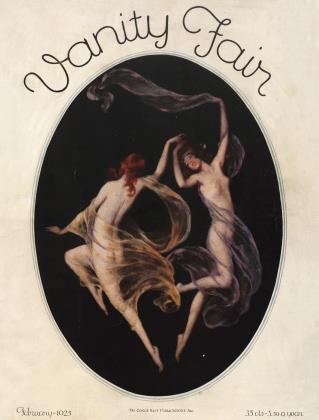Sign In to Your Account
Subscribers have complete access to the archive.
Sign In Not a Subscriber?Join NowA Pretty Pleiad of Precious Poets
Biographies of Some Modern Lyricists
RUBY ABRAMOVICH (centre) suggests, by her aspect, Judith, Semiramis and Sappho. Prom this intense, raven-haired vampire we feel entitled to expect a steady geyser of passion undiluted by regard for prohibition, blue laws and the censorship. But—shall we say, alas?—we are mistaken. Ruby's interest lies in sunny gardens, babies, beliefs and civic improvement. Her published books of verse include: Cradle Songs When Evening Hovers, Columbia Calls, Daffodils and Dimples and Ceres; A Masque of Agriculture (performed with great success at the opening of the Art Stadium in Tinkersville Centre, Vermont, where Ruby spends her summers).
ALOYSIUS CABOT is a case for Freudian psychologists. He is practically riddled with New England complexes: his inhibitions have a truly fearful way of exploding into exhibitions. Thus, his face gives practically no indication of the erotic fervour, the allembracing belligerency and the extreme grammatical licence of his poetry. Who would think him the author of: in the garden of sin? Or nietzsche über alles? Or again of i wash My linen? Aloysius wears a black cape, owns a bulldog, goes to prizefights, and adores the movies. He has never knowingly used a capital in order to indicate a proper name. His last volume was printed upside down.
HILDEGARDE POTTS (right) is so unique in her personal décor that we will be forgiven if we refuse to pronounce a diagnosis. Indeed, we shall only be echoing the mental reaction of the waitress in Child's Restaurant who, on seeing Hildegarde pace pensively in, clutching her red enamel cane, and preceded by her pet marmoset, incoherently exclaimed: "What is it? "What, en effet? This interesting poetess is given to peplums, potations and psychical research. Her art is post-vers libre and goes Gertrude Stein one better. From her first book: Après Moi Le Deluge through the ensuing Synthetic Skyscrafers and Cubic Carnations we can trace Miss Potts' gradual advance into the subconscious. Everyone remembers her ode beginning: "Reluctant onions pittances to cabs". Hildegarde has not done her Latin Quarter for nothing, and when Shakespeare is mentioned she merely remarks: "Bosh!".
GEORGE H. R. STEER may look comfortable, but his soul is as fragile as the tenuous long-drawn wail of a violin. So shy and self-effacing is he that at the sight of an acquaintance he drops down the nearest man-hole. The very odour of a beefsteak nauseates him. His sonnets and epics, written in Tennysonian metre, are expressions of a wistful melancholy, a degout de vivre, the melodious disenchantment of a spirit irreparably wounded. Lovers of classic forms are possessors of his vellum-bound productions: My Silver Shoon, The Laye of Faye Morgana, and Thorns Among The Roses. His favourite poet, as might be surmised, is George H. R. Steer; also—it might be remarked—his favourite critic is the same Steer. He has a faint, tolerance for one or two others—Verlaine he thinks not bad and, perhaps, also Rimbaud. America he regards as artistically unspeakable. He is addicted to cameo rings, prints after Burne Jones, plovers' eggs and incense.
Diverse as the gold and silver stars are these followers of the occult Muse, and unsympathetic as well. George hates Ruby's verse, and Ruby is repelled by the physique of George. Hildegarde and Aloysius together are as the fretful tiger and his mate. There is strife among them all. But one bond, as subtle and fine as a thread of steel, and as deathless, unites them. One glittering ambition, one fragile hope herds them towafd a common goal—some day, some happy day, to publish a poem in the fastidious pages of Vanity Fair!
JOHN SAVAGE
 View Full Issue
View Full Issue






Subscribers have complete access to the archive.
Sign In Not a Subscriber?Join Now